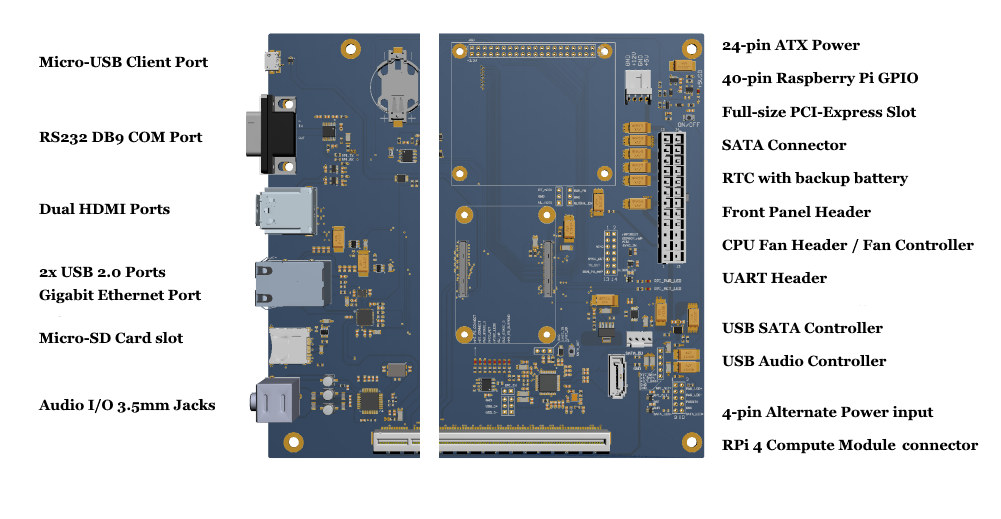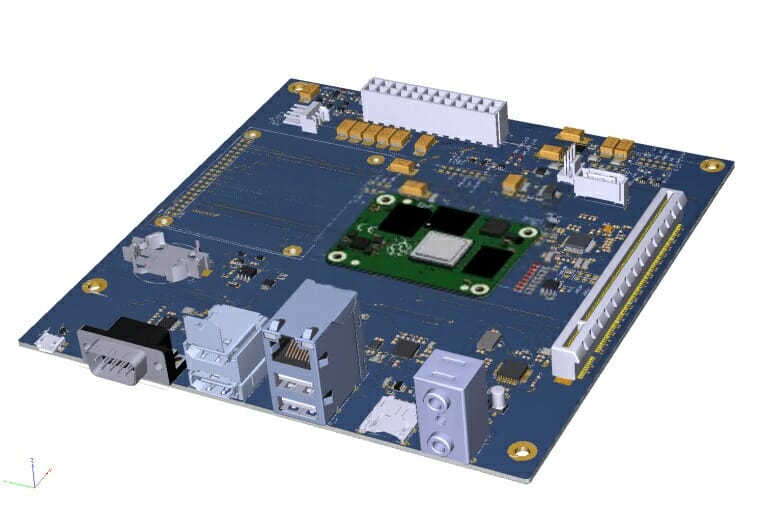While the Raspberry Pi 4 SBC is popular for its small form factor, affordable hardware, and good software support, the Raspberry Pi Compute Module 4 offers more flexibility and allows makers and companies to design their own hardware matching their requirements, while still leveraging the existing software support.
We’ve already seen a mini-ITX carrier board for the Raspberry Pi 4, namely the upcoming Turing Pi 2. However, the board has very specific use cases in mind since it’s a cluster board designed for four Raspberry Pi Compute Modules 4. But British engineer Ross Nicholls has designed Over:Board carrier board for Raspberry Pi Compute Module 4 for most traditional use cases, in essence, designing what amounts to a Raspberry Pi 4 mini-ITX motherboard with SATA, PCIe, etc.
Over:Board specifications:
- Compatible SoM’s – Raspberry Pi CM4 or CM4Lite with Broadcom BCM2711 quad-core Cortex-A72 processor, up to 8GB RAM, up to 32GB storage. optional Wireless module (WiFi 5 + Bluetooth 5)
- Storage – MicroSD card slot, SATA port via USB SATA controller
- Video Output – Dual HDMI 2.0 outputs
- Audio – 3.5mm audio jack via USB audio codec
- Networking – Gigabit Ethernet port; optional wireless on RPi CM4
- USB – 2x USB 2.0 host ports, 1x Micro USB client port
- Serial – DB9 COM port (RS232)
- Expansion
- 40-pin Raspberry Pi GPIO header
- Full-size PCIe 1x V2.0 slot
- Debugging – UART header
- Misc – RTC with a backup battery, front-panel header, CPU fan header/fan controller
- Power Supply – 24-pin ATX connector, 4-pin alternate power input
- Dimensions – 170x170mm (Mini-ITX form factor)

The board has just been launched on Indiegogo as a flexible funding campaign. As you can see from the renders, the board does not exist yet, even in prototype form. But Ross claims to have 20+ years of experience in hardware and software development having designed many such PCBs. Since it’s a personal project, he didn’t include information about his company/employer, which does not help with trust. I could however find one Ross Nicholls in CHELTENHAM, UK that specializes in 3D printing and low-volume production.
Nevertheless, production is scheduled to take place in three steps:
- 15 prototype boards from 3 manufacturers available in March 2021, 9 of which will be sent to backers who pledge around $271+ US.
- 50 to 100 pre-production boards (depending on demand) for a trial run in May 2021. Required pledge: $203+ US.
- Full production batch for 99 GBP ($135 US) per unit scheduled for September 2021.
Price is a little on a high-side, and it might have also helped to complete stage 1 before the crowdfunding campaign. We’ll see how it goes.
Via LinuxGizmos

Jean-Luc started CNX Software in 2010 as a part-time endeavor, before quitting his job as a software engineering manager, and starting to write daily news, and reviews full time later in 2011.
Support CNX Software! Donate via cryptocurrencies, become a Patron on Patreon, or purchase goods on Amazon or Aliexpress





